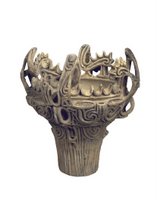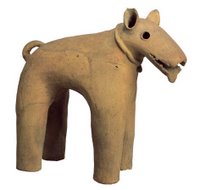 Since you landed on this page, you must be an art lover. And if indeed you are, then you must also appreciate ancient art and artifacts. So how about such gems as fine Paleolithic (33,000-10,000 BC) projectile points made of obsidian volcanic rock? Or a stunning rarity, one of the oldest - twelve century, to be exact - pottery vessels in existence? Or a statuette of an extraterrestrial? (Photo 1 on the left; also see detailed explanation at the end of the article.) You have never seen such antic rarities? Actually, nobody outside of Japan has ever seen those items before, until very recently.
Since you landed on this page, you must be an art lover. And if indeed you are, then you must also appreciate ancient art and artifacts. So how about such gems as fine Paleolithic (33,000-10,000 BC) projectile points made of obsidian volcanic rock? Or a stunning rarity, one of the oldest - twelve century, to be exact - pottery vessels in existence? Or a statuette of an extraterrestrial? (Photo 1 on the left; also see detailed explanation at the end of the article.) You have never seen such antic rarities? Actually, nobody outside of Japan has ever seen those items before, until very recently. If you do love ancient art and history, and especially if you are a Japan aficionado, then come to the Montreal Museum of Archaeology and History at Pointe-à-Callière. And if you don’t live in Montreal or Quebec, then consider changing your summer travel arrangements and head for Montreal instead. I promise, you will be amused. There is no way of escaping the multitude of summer festivals, the fine cusine, and the French language and spirit. But of course, you will be mainly coming for art and history… Japanese history…

So find your way to the Japan Exhibition. Besides seeing real archaeological digs and learning about fascinating Montreal history, you will be catapulted into the ancient past and find delight in the vessel mentioned above (Photo 2 on the right), crafted during the prehistoric Jomon period (10,000-400 BC), even before the Japanese state emerged. It was fired in an open pit, and is very fragile.
You will also see a Jomon vase with a flame motive, usually displayed in the Highlights of Japanese Art gallery at the Tokyo National Museum (Photo 3 on the lower right), and other enormous clay vessels with unique decorative cord design. The finding of such antique items made archaeologists conclude that pottery-making had originated in the Far East.You will also see dogu figurines, the role of which still remains a mystery.
Actually, a lot of mystery is especially attributed to the one in Photo 1 above. You might have seen the picture of it reproduced in books and articles on extraterrestrials as evidence that Earth was visited by beings from outer space. This statuette is considered by many to represent an extraterrestrial astronaut. Its huge eyes cover more than half of its face. They are indeed very non-oriental eyes. Could those be protective goggles with slits for vision in the middle? Still many scientists argue that this small statue merely suggests that the ancient civilization attributed magical powers to eyes. But that is only an opinion. I invite you to be your own judge. You will also see items from Yayoi period (300 BC – 300 AD), which is referred to as “rice period” when newcomers mainly from Korea brought with them the agricultural as well as metallurgical know-how. Some impressive bronze bells - dotaku - are also on display, along with ceremonial weapons.
 And then comes the famous Haniva “old tomb” period, also called Kofum (4th – 7th century AD), when huge burial mounds were build throughout Japan with earthenware animals and human figurines standing guard. They included soldiers and other professions, as well as houses and boats. As for animal lovers, you will adore the terra cotta dog (Photo 4 on the left). Even in those ancient times, dogs were already our companions, our pets, and were portrayed in artifacts.
And then comes the famous Haniva “old tomb” period, also called Kofum (4th – 7th century AD), when huge burial mounds were build throughout Japan with earthenware animals and human figurines standing guard. They included soldiers and other professions, as well as houses and boats. As for animal lovers, you will adore the terra cotta dog (Photo 4 on the left). Even in those ancient times, dogs were already our companions, our pets, and were portrayed in artifacts.At the end of Kofum period major events took place: introduction of writing and Buddhism, establishment of the first central government, adaptation of laws and institutions brought from China. For the first time a word designating Japan was used: Nipon – “Rising Sun”. Thus the Japanese state was born. And this where the exhibition theme ends.
The archeological objects at the exhibition, all 150 of them, are among the most important items of Japan’s heritage. They come primarily from the Tokyo National Museum, as well as from ten other Japanese museums. These objects have never left Japan before. They will be on display until October 15, 2006. After that the entire collection returns back to Japan.
The items on display are true museum treasures. They cannot be put on your book shelves, or placed in the middle of your coffee table, or be framed and hung on a wall behind a couch in your living room. These are not decorative pieces to enhance our present home environments. Nevertheless, though distinctly ancient, there is a hint of modernity in some of them. Wouldn’t you agree that the dog in Photo 4 could have been produced by a modern artist?
Come and see this exhibit. It attests to the liveliness of the spirit of ancient Japan, and to the treasures of our global cultural heritage.
Where: Montreal Museum
350 Place Royal, Montreal , QC
H2X 3Y5 , Canada
When:May 16 - Oct. 15, 2006
Museum's Website:
Photo 1
"Goggled” dogu
Important Cultural Property
1000 to 400 BC, Prehistoric period Jomon (10,000 to 400 BC)
© Tokyo National Museum collection
This dogu (“clay figurine”) is a ritual object. It is among the largest of its kind (36 cm high) and the best-preserved object from Japanese prehistory.
Photo 2
Important Cultural Property
1000 to 400 BC, Prehistoric period Jomon (10,000 to 400 BC)
© Tokyo National Museum collection
This dogu (“clay figurine”) is a ritual object. It is among the largest of its kind (36 cm high) and the best-preserved object from Japanese prehistory.
Photo 2
Deep bowl
10,000 BC, Prehistoric period Jomon (10,000 to 400 BC)
© Kokugakuin University Archaeology Museum
This bowl, dating from the Incipient Jomon, was discovered in a cave in theNagano
Photo 3
10,000 BC, Prehistoric period Jomon (10,000 to 400 BC)
© Kokugakuin University Archaeology Museum
This bowl, dating from the Incipient Jomon, was discovered in a cave in the
Photo 3
“Flame-style” deep bowl
3000 to 2000 BC ,Prehistoric period Jomon (10,000 to
400 BC)
© Tokyo National Museum collection
This earthenware bowl, with its superb relief motifs,
shows that its maker was a true master potter. It is usually displayed in the
Highlights of Japanese Art gallery at the Tokyo National Museum
Photo 4
Haniwa dog
Photo 4
Haniwa dog
6th
century, Prehistoric period Kofun (250 to 600 AD)
© Tokyo National Museum collection
Its ears erect, eyes wide open and tongue dangling, this is a Japanese dog ready to assist its master. The bell around its neck shows that the dog was domesticated, although the sound wouldn’t have helped with the hunt!
© Tokyo National Museum collection
Its ears erect, eyes wide open and tongue dangling, this is a Japanese dog ready to assist its master. The bell around its neck shows that the dog was domesticated, although the sound wouldn’t have helped with the hunt!

1 comment:
As far as I remember, modern Japanese language can be traced to Korean. Are there any linguistic traces of Jomon culture in modern Japanese?
Post a Comment